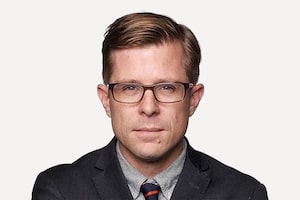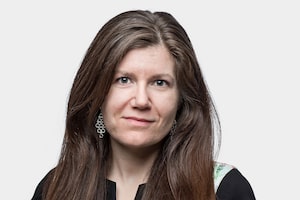Protesters meet to decide if they should maintain their anti-public-health-measures blockade at the Ambassador Bridge on Feb. 11. An injunction to clear the border crossing went into effect at 7 p.m. ET.CARLOS OSORIO/Reuters
Protesters who have been blocking the Ambassador Bridge, Canada’s most important trade artery with the U.S., on Friday faced a provincial state of emergency that could mean $100,000 fines or jail terms, and declarations from both the Prime Minister and the U.S. President that the disruption must end.
In addition, an Ontario Superior Court judge granted an injunction against the protests at the bridge, which goes from Windsor, Ont., to Detroit, ordering demonstrators to clear the area. Lawyers for the City of Windsor and the auto industry sought the order, saying the blockades forced the shutdown of auto plants and local schools.
The judge gave protesters until 7 p.m. to clear out, but crowds continued to grow after that, and it remained unclear when many would leave.
At Queen’s Park, Ontario Premier Doug Ford declared a state of emergency, both to deal with the situation at the U.S. border and what he called a “siege” in Ottawa, saying his cabinet will enact orders threatening anyone who blocks bridges, highways or other “critical infrastructure” with heavy fines and up to a year in jail.
Ontario Premier Doug Ford attends a news conference at the Queen's Park Legislature in Toronto on Feb. 11.Chris Young/The Canadian Press
Business groups call on governments to end border blockades in open letter
Speaking in Ottawa, Prime Minister Justin Trudeau said the borders would reopen but that he couldn’t provide details on timing or how the blockades would be stopped because “we are concerned about violence.”
Mr. Trudeau spoke with U.S. President Joe Biden on Friday about the disruptions at border crossings in Ontario, Manitoba and Alberta.
“President Biden and I both agree that for the security of people and the economy, these blockades cannot continue. So make no mistake, the border cannot and will not remain closed,” the Prime Minister said.
In a readout from the meeting, the White House said Mr. Trudeau promised the President that “quick action” would be taken. It also said that the U.S. administration and Michigan Governor Gretchen Whitmer are providing assistance but did not elaborate.
A source with knowledge of the meeting told The Globe and Mail that officials in the U.S. have offered up tow trucks to help deal with the Ambassador Bridge blockade. The Globe is not identifying the source because they were not permitted to disclose the internal plans.
The Prime Minister said he also raised the issue of U.S. involvement in the protests. Mr. Trudeau told reporters that on some fundraising sites, the percentage of funds coming from the U.S. is “approaching 50 per cent.” He also said he discussed the U.S.-based flooding of Ottawa’s 911 system this week, and the presence of U.S. citizens at the blockades.
Prime Minister Justin Trudeau speaks on Parliament Hill during a media availability about the ongoing protests in Ottawa and blockades at various Canada-U.S. borders on Feb. 11.Justin Tang/The Canadian Press
The Ontario Premier said blocking the Ambassador Bridge threatens hundreds of millions of dollars a day in two-way trade between Canada and the U.S., and puts hundreds of thousands of Ontario jobs at risk. He also said those blocking Ottawa streets with trucks were taking a part in an “illegal occupation” and urged them to leave, including those who have brought children to both protests.
“To those who have attempted to disrupt our way of life by targeting our lifeline for food, fuel and goods across our borders, to those trying to force a political agenda through disruption, intimidation and chaos, my message to you is this. Your right to make a political statement does not outweigh the right of hundreds of thousands of workers to earn their living,” Mr. Ford said.
“Your right to make a political statement does not outweigh the rights of one million people in Ottawa to live peacefully, free of harassment and chaos in their own homes.”
Under Ontario’s emergency legislation, used in the pandemic several times already, the Premier can declare a state of emergency himself but his cabinet must ratify it within 72 hours. Cabinet was expected to meet Saturday, if not sooner, to approve the declaration and the emergency orders. The initial state of emergency lasts 14 days. It can be renewed for another 14 days before going before the legislature for a vote.
Mr. Ford said he is also looking at orders that would empower the government to go after the personal and commercial drivers’ licences of protesters who refuse to leave.
The opposition NDP has been urging the government to suspend commercial trucking licences for those involved. But Ivana Yelich, a spokeswoman for Mr. Ford, said government lawyers did not believe current legislation allowed for licences to be seized after vehicles were used in a protest.
Mr. Ford also said he intended to make the emergency orders and penalties permanent, with legislation in the coming spring session, which starts Feb. 22.
The Premier said the province’s public-health restrictions, already being lifted on a gradual timeline, were necessary to keep overwhelmed hospitals from turning away patients. But he said the province is “on track to very soon” remove most restrictions on businesses.
And Mr. Ford pointed to comments this week from Ontario Chief Medical Officer of Health Kieran Moore, who said the province’s vaccine passport system is under review and that he will present options to the government next week on a timeline for ending it, as hospital admissions continue to decline.
But the Premier said he was not moving faster to placate the protesters: “I will never, ever negotiate with people that break the law … people that are in there illegally occupying cities. I base it on health. I base it on science.”
Susan, an anti-public-health-measures protester who wouldn’t give her last name, walks past police officers after yelling at counter-protesters at the Ambassador Bridge in Windsor, Ont., on Feb. 11.The Globe and Mail
Meanwhile, RCMP in Manitoba on Friday confirmed protesters at the U.S. border crossing near Emerson, Man., are still allowing emergency vehicles and trucks hauling livestock to pass through a blockade of about 50 semis, pieces of farm machinery and passenger vehicles.
Manitoba Premier Heather Stefanson on Friday said the province will accelerate its plan to roll back COVID-19 restrictions and expects to have all public-health orders lifted in the coming weeks.
In Alberta, protesters have organized weekend convoys across the province, with Edmonton, Calgary and Milk River as key destinations.
They set up camp at the police checkpoint just south of Milk River last week, and the demonstration ballooned on the weekend. The police barricade was established to limit access to the protest in Coutts, which is blocking traffic at the U.S. border.
Between 200 and 250 vehicles were gathered at the Milk River site early Friday afternoon, according to RCMP Corporal Troy Savinkoff. About 75 to 100 vehicles, including farm equipment, remained at the protester blockade in Coutts.
In British Columbia, a protest against COVID-19 health measures has been taking place at Surrey’s Pacific Highway U.S. border crossing since Saturday.
With reports from Xiao Xu and The Canadian Press
Our Morning Update and Evening Update newsletters are written by Globe editors, giving you a concise summary of the day’s most important headlines. Sign up today.
 Jeff Gray
Jeff Gray Marieke Walsh
Marieke Walsh Carrie Tait
Carrie Tait Eric Atkins
Eric Atkins